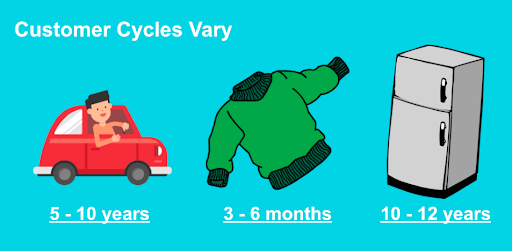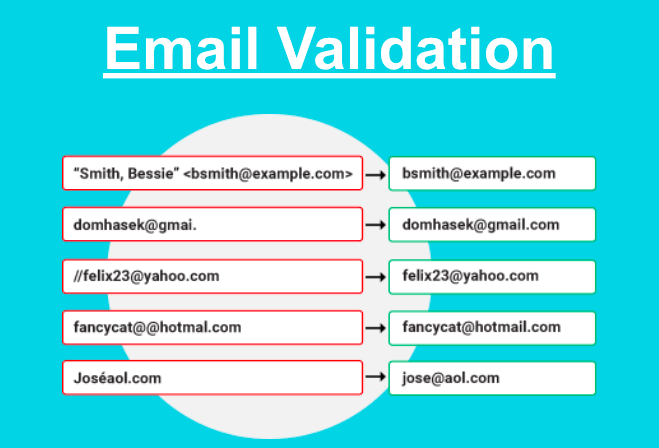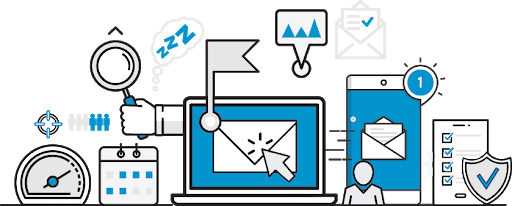If you’re struggling with a less-than-ideal domain reputation and/or poor email deliverability, it might be time to take a closer look at your database’s email engagement. Why analyze your email engagement? In this blog, we’ll discuss why determining inbox activity level is key to unlocking the customer buying cycle, thereby improving deliverability, domain reputation, and your email marketing program’s overall engagement for highly active and even unengaged contacts.
Buyer’s Journey vs Buying Cycle
The first step is making sure you’ve got our definitions in line. While we often hear the terms “buyer’s journey” and “buying cycle” thrown around in the marketing world, it can be easy to confuse the two. It will be important to know the difference later, so let’s define them now:
- Buyer’s Journey: The steps a customer takes to make an initial purchase. The focus here is the sale.
- Buying Cycle: The entire journey from initial purchase to return purchases. The focus here is nurturing the relationship.
The journey is pretty cut and dry for most target customers in your marketing plan, but the cycle can vary depending on what’s being purchased. For example, customers may buy clothing items every 3-6 months, but car purchasing cycles typically span 5-10 years, and major appliance purchasing cycles can span from 10-12 years.

What’s important to learn from these buying cycles though, regardless of length, is who are your active customers and who are your passive customers. But what is a passive customer and why does investing in content for them matter?
Defining the “Passive Customer”
Passive customers are people who at one point expressed interest in your product or service but have become passive in their engagement with your emails. Rather than selling at this point, you should provide information, resources, and a friendly check in. In short, don’t keep them on the same cadence and/or frequency of your active subscribers. This will lead to:
- Mass unsubscribes
- Being marked as spam
- Having your emails and brand ignored
All of the above lead to a tarnished domain reputation, and those individuals waiting to hear from your brand will no longer have that opportunity.
This is why you should take the time to create content for your passive customers. Just like a credit score determines credit worthiness, so too does your domain score / reputation in determining whether or not your email is worthy of making it to the inbox. It’s no longer just a question of IP address health. Now, you have to address your domain score (email opens, replies, shares, etc) to ensure optimal deliverability.
Improving Your Domain Score with Email Validation
Email Validation does a plethora of things for email marketers, such as:
- Removing invalid and risky emails from your CRM
- Identifying only valid and current email addresses
- Helping increase your domain reputation
- Leads to better inbox placement, higher open rates, and increased revenue attributed to email campaigns
- Reducing operational costs
- Helps Sales no longer waste time following up with old contacts
- Reduces CRM or ESP spend with removing invalid email addresses

With these benefits gained from running email validation for your brand, you eliminate the larger risks that negatively impact your sending domain’s reputation, specifically the potential for unengaged or previously engaged contacts to mark your content as spam. With a clean, validated database, you can now determine who your passive customers are.
Discovering Your Passive Customers
There are two common ways to determine who your passive customers are from your database at large, and both involve tools in your toolbox. We recommend using:
- A Trends Tool
- Open Data
Trends Tool
We’ve been talking a lot about passive customers so far, and how important it is to send them relevant content, but they shouldn’t be your main focus. Active customers provide 80-85% of your overall email engagement and are 10x more likely to engage with your email.
Since active customers do so much for your business, it makes sense to send them more content, more frequently than your “passive” and “inactive” subscribers or customers. Use your time wisely and send the offers to those who are interacting with your brand! Seventh Sense actually builds trends on individuals to predict activity in an email program, so you can have the trend data you need right at your fingertips to segment more active customers from your passive and unengaged customers.
Open Data
Another tool that’s great for determining passive customers is Open Data. How does it work? Open Data analyzes your database against data sourced from over 200M US consumer emails. Then, the emails are matched against customers emails to identify the most active “openers”.

Not only does sending relevant content to active and passive customers help your domain reputation (as we previously mentioned), but it also aids in:
- Reducing bounce rates
- Eliminating sending to truly inactive email inboxes
- Increasing your open rates (typically results in a 3x increase)
- Refining email marketing program metrics
By taking the time to determine and segment active customers from passive customers, you make the next step in the process that much easier.
Campaign Planning for Passive Customers
We’ve mentioned it a couple of times, but it’s critical to implement distinct, relevant creative content for your passive customers that differs from the content you send to active customers. You can use the same basic ideas, but two simple shifts in your content will make all the difference:
- Adjusting the content/offer (is that the right blog or promotion for this customer?)
- Adjusting the frequency (do daily offers really work?)
When you implement these two shifts in your content and monitor your inbox placement with tools like Google Postmaster Tools, you’ll see a major difference in your engagement metrics along with your email deliverability.
But don’t just take our word for it. Here are a few case studies from real customers.
Open Data Identifies Active Users from Inactive Lists
In most cases, clients using Open Data upload their email file(s) containing inactive or unengaged customers. Open Data services then identify who has been actively opening emails in the past 3 months from other senders. Next, the clients add the newly identified, recently active emails to incentive-based re-engagement campaigns.
What’s an incentive-based campaign? In short, it’s a campaign that provides the individual an incentive to re-engage. This can be:
- A discount
- Free shipping
- Two-for-one offer
- Etc …
When TowerData’s client approached an incentive-based re-engagement campaign this way, they saw a 3x higher open rate than their standard sends with 10%-15% re-converting to engaged, active status. Remember, this makes a huge impact on the brand’s email marketing program because clean, active data allows email marketers to capitalize on a user’s second lifetime value!
Reversing “Bad” Domain Reputation and Low Engagement in 2 Phases
Seventh Sense works with a brand whose domain had a “bad” reputation listing (lowest of 4 levels) from Google in March 2019. Remember, having a poor domain reputation means emails are likely to land in spam folders instead of the inbox. Additionally, in the 12 months prior to implementing Seventh Sense, the brand averaged a 7.97% open rate, and .32% click rate - well below industry average.
We approached them with a two-part solution:
- Deliverability Optimization
- Throttling sends lowers risk of triggering spam filters
- Creating activity segments to allow for easier sender reputation management
- Pausing the program during the assessment to avoid risks/mistakes
- Engagement Optimization
- Send time optimization to increase opens/clicks
- Better timing to increase conversions
- Work to increase desktop clicks to maximize conversion
Phase 1
In Phase 1, the Seventh Sense algorithm identified large numbers of inactive and passive contacts. Then, by decreasing email frequency to contacts who were not engaging, the team was able to quickly increase global email engagement metrics for both of the company's brands. And the decision to pause, while it led to lower overall volume and short term decreases in the total opens/clicks, allowed deliverability to quickly improve.
Optimizing send times was the other element to Phase 1 success. Here, the goal was to learn customers’ patterns with every mailing. With email delivery time optimization, the chances that prospects will see, open, click and convert from email increase. It’s an easy fix, especially since many organizations’ spam filters tend to suppress bulk mailings. By spreading delivery out over time, deliverability naturally reduces this risk.
The key results from Phase 1 were as follows:
- 50% reduction in email volume
- 16.1% increase in total opens YoY
- 19.6% increase in total clicks YoY
- 139.9% Open rate increase YoY
- 150.0% Click rate increase YoY
Phase 2
In this second and final phase, the goal was to leverage the brand’s newly increased domain reputation to re-engage previously dormant contacts, or passive customers. As the brand’s domain reputation with Google increased to “Medium”, the team decided to take advantage of the increased deliverability the team had built over the summer to reach a wider audience and email new leads. This meant the messaging had a greater chance of inboxing even with increased volume to passive customers whose emails may have previously gone to spam.
At the end of the day, segmenting passive customers and sending relevant incentive-based re-engagement campaigns from a domain with a better reputation resulted in:
- 31.3% increase in total opens YoY
- 124.5% increase in total clicks YoY
- 36.5% Open rate increase YoY
- 131.4% Click rate increase YoY
